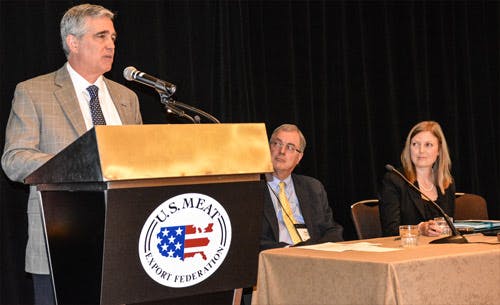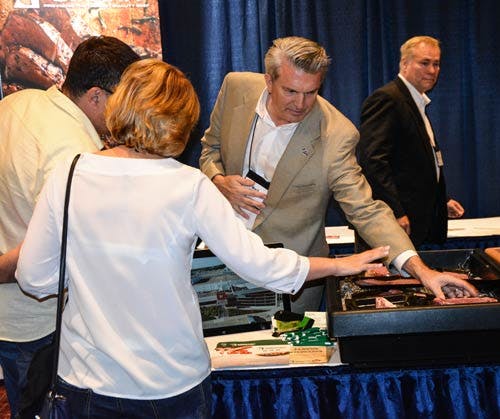Thursday Board Meeting Highlights: Exchange Rate Panel, Standing Committees, Product Showcase
Day two of the USMEF Board of Directors Meeting in St. Louis featured a panel discussion on one of the most difficult challenges currently facing U.S. meat exports – currencies and exchange rates. USMEF Economist Erin Borror provided a global overview of recent exchange rate trends, which continue to reflect weakness versus the U.S. dollar for many currencies in key export destinations, as well as for most meat-exporting countries that compete with the United States.

(from left to right) Michael Drury of McVean Trading, USMEF Chair Roel Andriessen and USMEF Economist Erin Borror discuss the impact of currencies and exchange rates on red meat trade
Michael Drury, chief economist for McVean Trading, addressed some of the factors driving changes in exchange rates and explained their impact on global trade and the world economy. Drury noted the recent trend in which many countries took measures to devalue their currencies in response to the economic slowdown in China, and for the purpose of making their products more competitive in international markets. He warned, however, that this is a short-sighted approach that rarely strengthens a nation’s economy in the long term.

The USMEF Product Showcase brought buyers and sellers together in St. Louis
Thursday’s general session also included a panel discussion on Russia’s role in global meat trade, with a specific focus on how Russia’s declining meat imports have impacted pork and beef trading patterns worldwide.
Borror explained the impact of Russia’s closure to pork imports from the European Union, which first took effect in early 2014. Russia had been the largest destination for EU pork, so the suspension of imports created a surplus of pork for which the European industry has aggressively sought alternative destinations. She noted that Russia also closed to Canadian pork in August 2014 in response to economic sanctions imposed due to the conflict in Ukraine. At that time Russia was the third-largest destination for Canadian pork.
Yuri Barutkin, USMEF manager based in St. Petersburg, Russia, provided USMEF members with an on-the-ground look at developments in Russia’s domestic pork industry and reported on Russia’s aspirations of achieving self-sufficiency in pork production. He explained that Russia is also pursuing export destinations for its domestic pork, due in part to the weak level of consumer purchasing power within the country.
Joel Haggard, USMEF senior vice-president for the Asia Pacific, spoke to the impact of the large influx of European pork entering key Asian markets since the Russia closure. He said the intensified level of competition makes it all the more important that the U.S. industry differentiates its products based on attributes other than price. He said it is also critical that U.S. suppliers educate their customers on the advantages of chilled U.S. pork in markets such as Japan and South Korea and explain the advantages of pork arriving fresh from the United States compared to European pork that arrives frozen, then is thawed after reaching its final destination.
All three panelists emphasized that even when Russia reopens to EU pork, the competitive landscape will remain vastly different from the past. Russia’s imports will likely be much smaller due to its increase in domestic production and weakness of its currency, and European suppliers will aggressively seek to maintain the gains they have made in Asian markets.

More than 130 buyers from across the world attended the USMEF Product Showcase, which featured U.S. exporters displaying beef, pork and lamb
A major highlight of Thursday’s meeting agenda was the USMEF Product Showcase, which provides a venue for USMEF member companies to connect with prospective customers from across the globe. More than 130 meat buyers attended this year’s event, in which USMEF member companies displayed beef, pork and lamb products during a very active session that featured both face-to-face business discussions and product demonstrations.
Among the buyers visiting with U.S. companies and sampling their products were members of 16 trade teams from key markets around the world. Prior to arriving in St. Louis for the USMEF Product Showcase, these teams spread out across the Midwest to observe U.S. meat production, processing and merchandising practices. They also visited farms and ranches to get a better understanding of U.S. agriculture.

Buyers were able to learn more about U.S. red meat products and taste a wide variety of samples at the USMEF Product Showcase
One of the farming operations visited is owned by Wayne Humphreys, a grain and livestock producer from Columbus Junction, Iowa, and a director of the Iowa Corn Promotion Board (ICPB). Commodity organizations like ICPB help fund USMEF activities in different parts of the world, as well as events like the Product Showcase. Attending the event in St. Louis convinced Humphreys that it is a worthwhile endeavor.
“This showcase is absolutely wonderful,” Humphreys said, “We spend so much time and so much effort getting buyers and sellers together, and that’s what is happening here tonight – people are writing orders, taking samples and making arrangements for shipments. This is exactly what we hoped for with the investments we’ve made to this point. There’s enthusiasm, there are eager buyers and sellers – we hope to do this for a long, long time.”
Mike Burger, a trader with Transtrade International in Cape Town, South Africa, was on the African trade team led by USMEF representative Monty Brown. This was Burger’s first time in the United States, and he was impressed with what he discovered – both during site visits and at the USMEF Product Showcase.
“I’m amazed at the enthusiasm here and very excited at the opportunities and the number of people wanting to do business in South Africa,” said Burger, whose company purchases beef, pork and lamb. “We visited four states in three days, and now we are here in this wonderful setting at the Product Showcase, with people eager to do business. We hope to make many more trips to the U.S.”
Thursday’s agenda also included meetings of USMEF’s standing committees – the Beef and Allied Industries Committee, Pork and Allied Industries Committee and Exporter Committee – as well as the Feedgrain and Oilseed Caucus. Upcoming editions of the USMEF Export Newsline will include reports from the chairs of these committees, providing detailed outlines of the issues discussed.
